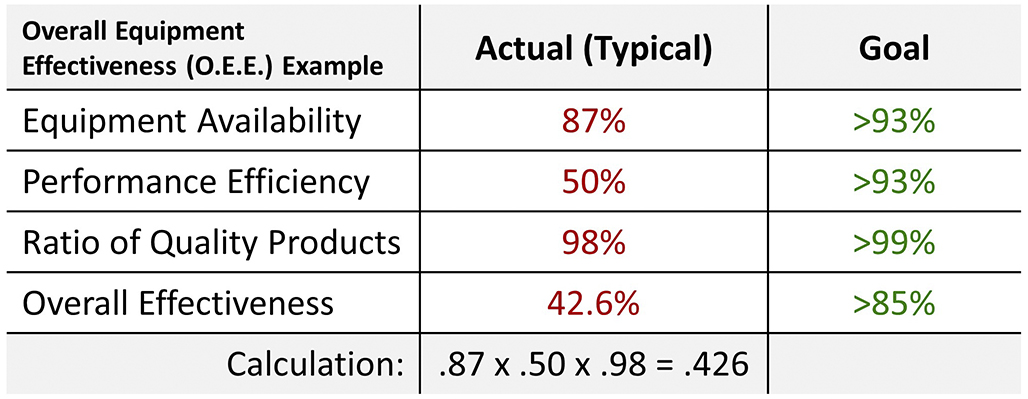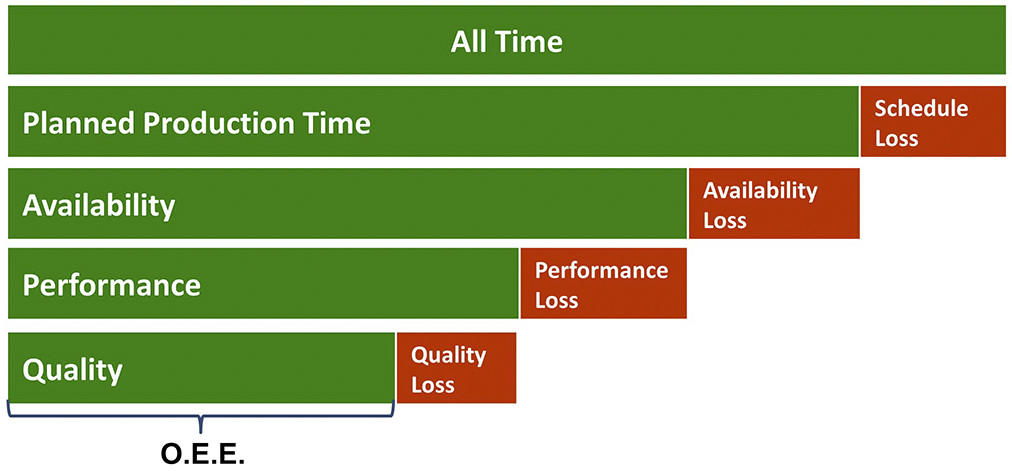Overall Equipment Effectiveness | O.E.E.
Overall Equipment Effectiveness (O.E.E) measures the time that an asset (machine) is producing product versus the theoretical maximum amount of time the equipment could be producing.
Developed by Denso during the 1960s and into the 1980s as part of Total Productive Maintenance (TPM), and later refined by the Japan Institute of Plant Maintenance, TPM and O.E.E. are intrinsic parts of Lean manufacturing.
Calculating Overall Equipment Effectiveness
The O.E.E. baseline calculation starts with the scheduled run time or; Planned Production Time. Do not include scheduled losses for breaks, lunch, shift change or no demand, etc. An improvement system called T.E.E.P (Total Effective Equipment Performance) optimizes for schedule loss.

O.E.E is the percentage of the total planned production time available, less the various forms of loss shown below. Calculate it by multiplying three ratios together:
- Equipment Availability = 100% – (Breakdowns + Setup + Other tool changes)
- Performance = 100% – (Idle Time + Minor Stops + Reduced Speed)
- Quality = 100% – (Defects and Rework + Startup and Yield Loss)
O.E.E. = Availability % x Performance % x Quality %

Availability is the ratio of Run Time to Planned Production Time.
Availability = Run Time / Planned Production Time
![]()
100% Availability means the equipment is running during Planned Production Time without unplanned or planned stop time. Breakdowns, unplanned stops, tool changes and equipment failures all reduce machine availability. An effective maintenance system improves machine availability.
Performance is the amount of time the equipment actually runs divided by the optimal run time possible:
Performance = Net Actual Run Time / Theoretical Optimal Run Time
![]() Anything that causes the machine to run less than the max possible speed like idling or minor stoppages reduces performance. Machine cycle time will deteriorate over time as equipment and tools wear out. A good Total Productive Maintenance (TPM) program helps ensure Net Actual Run Time stays high.
Anything that causes the machine to run less than the max possible speed like idling or minor stoppages reduces performance. Machine cycle time will deteriorate over time as equipment and tools wear out. A good Total Productive Maintenance (TPM) program helps ensure Net Actual Run Time stays high.
Quality is the loss of time attributed to producing defective or non-standard product, the same as First Pass Yield:
Quality = Total Good Units / Total Units Produced
 O.E.E Stack Up
O.E.E Stack Up
Overall Equipment Effectiveness is an important calculation for any Lean operation. The goal for O.E.E. is to objectively determine which of the Six Big Losses in Equipment Efficiency impacts your production. Prioritize and then attack these wastes and watch your O.E.E. scores improve along with productivity and profit.

